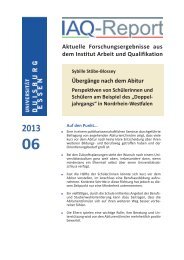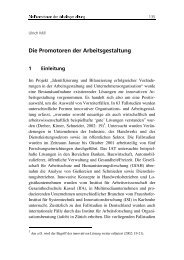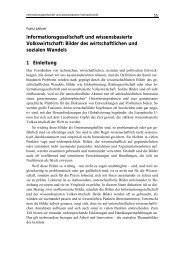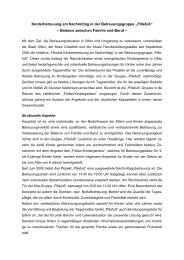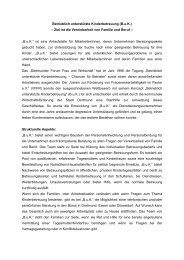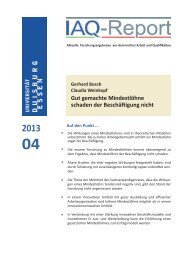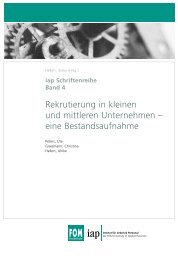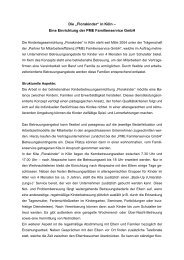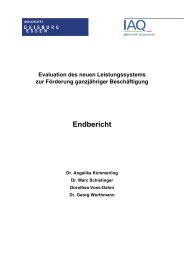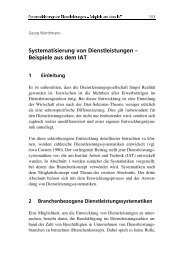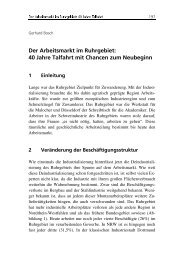Gerhard Bosch Working time and working time policy in Germany 1 ...
Gerhard Bosch Working time and working time policy in Germany 1 ...
Gerhard Bosch Working time and working time policy in Germany 1 ...
You also want an ePaper? Increase the reach of your titles
YUMPU automatically turns print PDFs into web optimized ePapers that Google loves.
<strong>work<strong>in</strong>g</strong> hours of West-German women are <strong>in</strong>fluenced by the conservative welfare state. High<br />
proportions are <strong>work<strong>in</strong>g</strong> few hours (Figure 9). Short <strong>work<strong>in</strong>g</strong> hours are made attractive by the<br />
so-called m<strong>in</strong>i-jobs. Employees <strong>in</strong> m<strong>in</strong>i-jobs are below a certa<strong>in</strong> earn<strong>in</strong>gs limit (less than €400<br />
per month s<strong>in</strong>ce 2003). They are not covered by the general obligation to pay social <strong>in</strong>surance<br />
contributions. Employers pay a flat-rate contribution of 30 per cent (13 per cent for health<br />
<strong>in</strong>surance, 15 per cent for old-age pension <strong>and</strong> a 2 per cent flat-rate tax). These m<strong>in</strong>i-jobs are<br />
attractive to housewives, s<strong>in</strong>ce the <strong>in</strong>come advantage by the splitt<strong>in</strong>g system <strong>and</strong> the derived<br />
entitlement to social protection is preserved. The marg<strong>in</strong>al deduction rates for an <strong>in</strong>crease <strong>in</strong><br />
<strong>work<strong>in</strong>g</strong> <strong>time</strong> above the m<strong>in</strong>i-job threshold is extremely high. Depend<strong>in</strong>g on the family’s tax<br />
rate, they can easily be <strong>in</strong> excess of 100% <strong>and</strong> thus acted as a very effective brake on any<br />
<strong>in</strong>crease <strong>in</strong> the female labor supply <strong>in</strong> particular, as the sharp <strong>in</strong>crease <strong>in</strong> marg<strong>in</strong>al part-<strong>time</strong><br />
work shows.<br />
Because women are <strong>in</strong>creas<strong>in</strong>gly <strong>work<strong>in</strong>g</strong> part-<strong>time</strong> their share <strong>in</strong> total volume of hours<br />
worked did not <strong>in</strong>crease as fast as their share <strong>in</strong> employment. Between 1991 <strong>and</strong> 2004 the<br />
share of women <strong>in</strong> total employment <strong>in</strong>creased by 4,6 percentage po<strong>in</strong>ts to 48,7%. In the same<br />
period its share <strong>in</strong> the total volume of hours worker only <strong>in</strong>creased by 1,7 percentage po<strong>in</strong>t to<br />
41%. In East-<strong>Germany</strong> the share of women <strong>in</strong> the total volume of paid work is much higher<br />
than <strong>in</strong> West-<strong>Germany</strong> (45,7% compared to 39,9%).<br />
Figure 8 Usual <strong>work<strong>in</strong>g</strong> hours of men <strong>in</strong> West- <strong>and</strong> East-<strong>Germany</strong> 2006,<br />
employees (16-64 years)<br />
70%<br />
60%<br />
50%<br />
40%<br />
30%<br />
20%<br />
10%<br />
0%<br />
1 - 9<br />
11<br />
13<br />
15<br />
17<br />
19<br />
21<br />
23<br />
25<br />
27<br />
29<br />
31<br />
33<br />
35<br />
37<br />
39<br />
41<br />
43<br />
45<br />
47<br />
49<br />
51<br />
West East<br />
Source: Kümmerl<strong>in</strong>g et. al. 2008 : 81<br />
14




